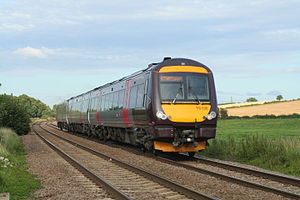Turbostar
| Turbostar | |
|---|---|

Class 170 in CrossCountry livery, westbound towards Leicester
|
|
| In service | 1998 – present |
| Manufacturer |
Bombardier Transportation, Derby (formerly ADtranz) |
| Constructed | 1998 – present |
| Number built | 196 trainsets |
| Formation | 2, 3 or 4 carriages per trainset |
| Capacity | Varies depending on number of cars and seating configuration, see individual articles for details |
| Operator(s) |
Abellio Scotrail |
| Specifications | |
| Car length | 23.62 m (77 ft 6 in) |
| Width | 2.69 m (8 ft 10 in) |
| Height | 3.77 m (12 ft 4 in) |
| Maximum speed | 100 mph (160 km/h) |
| Weight | Varies depending on number of cars and seating configuration, see individual articles for details |
| Prime mover(s) | MTU 6R 183TD |
| Safety system(s) | Various combinations of ATP, AWS, TPWS, Tripcock system |
| Coupling system | BSI/Dellner couplers (Class 171, see below) |
| Track gauge | 1,435 mm (4 ft 8 1⁄2 in) |
Abellio Scotrail
Abellio Greater Anglia
Chiltern Railways
Cross Country
London Midland
London Overground
Turbostar is the name given to a family of diesel multiple units (DMUs) built by Bombardier Transportation (previously ADtranz) at their Litchurch Lane Works in Derby, England. The Turbostar was the first new train type to be introduced after the privatisation of British Rail. The first units were ordered by Chiltern Railways in 1996 and were designated Class 168 (also known as Clubman). Since then the family has grown with the addition of the Class 170, Class 171, and the Class 172.
The Clubman/Turbostar/Electrostar platform is a modular design, which shares the same basic design, bodyshell and core structure, and is optimised for speedy manufacture and easy maintenance. It consists of an underframe, which is created by seam-welding a number of aluminium alloy extrusions, upon which bodyside panels are mounted followed by a single piece roof, again made from extruded sections. The car ends (cabs) are made from glass-reinforced plastic and steel, and are huck-bolted onto the main car bodies. Underframe components are collected in ‘rafts’, which are bolted into slots on the underframe extrusion. The mostly aluminium alloy body gives light weight to help acceleration and energy efficiency.
Much of the design is derived from the Networker Turbo Class 165 and Class 166 trains built by BREL. Notable features shared are the aluminium alloy frame and two-speed Voith T211r hydrodynamic transmission system. The diesel engine has changed to an MTU 6R 183TD. A cardan shaft links the output of the gearbox to ZF final drives (instead of Gmeinder in the Networkers) on the inner bogie of each vehicle. The engine and transmission are situated under the body; one bogie per car is powered, the other bogie unpowered.
...
Wikipedia
